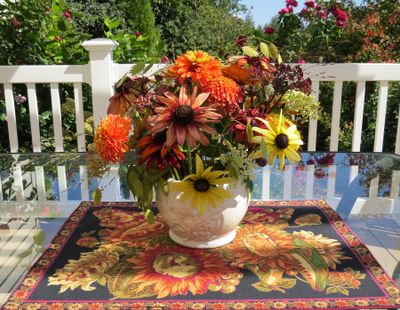In the Garden: Flowers that can stand the heat and flourish

While much of my garden was struggling through this summer’s heat and dry conditions, there were many flowers that came through it like champs. Everywhere I looked, I was greeted with colorful blooms that repeatedly reassured me, “We’ve got this.”
I started taking note of these “bombproof” flowers in our landscape and thought it would be nice to share the standouts with you. After all, if these plants could survive and even excel in the conditions that were thrown their way, then they deserve to be planted again and again. All of the following plants are annuals, meaning they grow, bloom, set seed and die in a single growing season.
I think the zinnias should be awarded first prize. They didn’t wilt in the heat and brightened their surroundings with nonstop blooms. I grew Queeny Lime Orange, Green Envy, Profusion Red Yellow Bicolor and Benary’s Giant from seed, and they have been fantastic.
Zinnias also make great cut flowers, which worked out well since I seemed to be stuck indoors more often than not while hiding out from the smoke and intense heat.
If you’re looking for striking blossoms, consider Gloriosa daisies. I’ve grown Cherokee Sunset and Indian Summer in the past, but Sahara is my new go-to favorite. The flower colors range from buttery yellow and copper to dusty rose. As a bonus, the plants are even deer resistant.
Cupcakes cosmos has been a favorite of mine for three years running. You would think their delicate, fernlike foliage and pastel blossoms with fused petals would become crispy in the heat, but they didn’t suffer any ill effects.
This spring, I planted a large deck container with some hummingbird favorites and was pleasantly surprised to discover how well they grew. I chose red-flowered plants that would draw in my favorite little bird friends, and they definitely accomplished that purpose.
A bright red canna lily (Cannova Bronze Scarlet), which is the centerpiece of the pot, is surrounded by Americana Coral geraniums and Vermillionaire firecracker plants (Cuphea). The hummingbirds visit each of these plants every few minutes, which tells me the flowers are providing them with plenty of nectar.
I should mention that the canna lily is actually a summer-flowering bulb that grows from a rhizome. It is very easy to overwinter the bulbs in a box indoors and plant them outside again after the danger of frost has passed. That’s a great way to enjoy them year after year.
Big Duck Yellow marigolds had a place of honor in our vegetable garden. They are a large-flowered variety with lush foliage and grow about 15 inches tall. I’ve often heard marigolds will repel insects with their pungent scent and decided to put them to work.
I’d be remiss if I didn’t mention the sunflowers that have been gracing our vegetable garden since mid-May. I planted Red Sun, Mammoth Grey Stripe and Italian White. The National Garden Bureau proclaimed 2021 to be the “Year of the Sunflower,” and I’m pretty sure my plants knew it. My goals for them had been to add a bit of color to the garden, attract pollinators and provide seeds for the birds to feast on this fall.
It turns out the sunflowers took advantage of their elevated status by growing about 12 feet tall. They’ve brought a smile to my face every day and occasionally a bit of concern about whether they’re intending to take over the planet.
Susan Mulvihill is author of “The Vegetable Garden Pest Handbook.” She can be reached at susan@susansinthegarden.com. Watch this week’s “Everyone Can Grow a Garden” video at youtube.com/susansinthegarden.